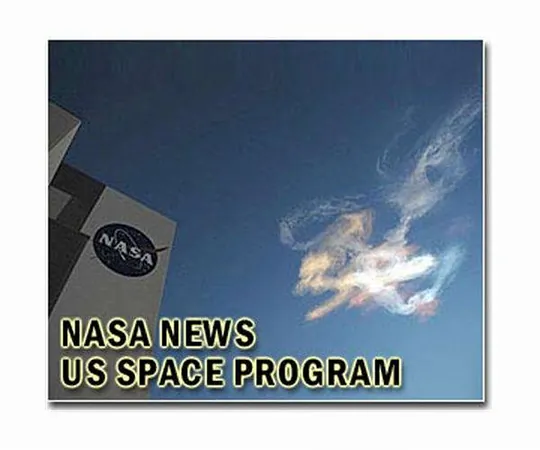
Unlocking Hidden Secrets: How NASA's Data Archives Fuel Scientific Breakthroughs
2025-04-02
Author: Arjun
NASA’s missions have long been synonymous with groundbreaking discovery and technological advancement. However, the adventure doesn’t end when a mission concludes; in fact, it's often just the beginning. The vast data archives maintained by NASA serve as a treasure trove of information, enabling scientists to make astonishing new discoveries years, or even decades, after the original data was collected.
“NASA's science data is one of our most valuable legacies,” said Kevin Murphy, the Chief Science Data Officer at NASA Headquarters. “It carries the narratives of our explorations and the potential for transformative new insights in numerous fields of research.”
A Data Powerhouse
With science data holdings surpassing an impressive 100 petabytes—equivalent to around 20 billion smartphone photos—NASA's archives encompass a wide array of scientific disciplines. From astrophysics and Earth science to planetary research and beyond, this extensive repository has become essential for scientific publications, with over 50% relying on archived data.
Managing such a colossal amount of information necessitates meticulous planning, state-of-the-art infrastructure, and innovative techniques to ensure that researchers can access this wealth of information securely and sustainably. Continuous investment in data storage and technological advancements is critical for empowering future generations of scientists who will draw upon NASA's findings.
Realizing the Past: Modern Tech Resurrects Old Data
Modern technology plays a pivotal role in extracting new stories from historical data. For instance, when NASA's Voyager 2 spacecraft conducted its iconic flyby of Uranus in 1986, the mission captured a wealth of data, but it wasn't until the early 2000s that advanced image processing techniques led to the discovery of two small moons—Perdita and Cupid—that had been overlooked.
Researchers revisited this archival data once again in 2024, uncovering a rare solar wind event that compressed Uranus's magnetosphere before the Voyager 2 flyby—a unique phenomenon that only occurs about 4% of the time, providing invaluable insights into the planet’s magnetic field.
The Lunar Frontier and Beyond
NASA’s Lunar Reconnaissance Orbiter (LRO), which launched in 2009, continues to redefine our understanding of the Moon. Its archival data played a crucial role in the 2018 discovery of water ice near the lunar poles. Recently, in 2024, new assessments revealed even broader evidence of water ice in permanently shadowed regions near the lunar South Pole, a finding that could significantly impact future lunar missions.
But NASA's data isn't just illuminating the Moon; it is also rewriting human history. In 2024, archaeologists identified a previously unknown Mayan city in Mexico's Campeche region, leveraging airborne data from the NASA Goddard LiDAR Hyperspectral and Thermal Imager (G-LiHT) mission.
Monitoring Earth’s Changes
The Harmonized Landsat and Sentinel-2 (HLS) project has become an invaluable tool for monitoring terrestrial transformations. By analyzing HLS data, researchers have been able to observe and track urban expansion, urban sprawl patterns, and shifts in land cover, enabling informed planning and sustainable development in rapidly growing metropolitan areas.
Harnessing the Future with AI
NASA is dedicated to pushing the boundaries of data utilization by investing in AI technologies to mine its archives for new discoveries. “Our vision is to develop an AI model for each of NASA's scientific disciplines, transforming decades of legacy data into a reservoir of revolutionary insights,” Murphy stated.
This collaborative effort involves NASA, IBM, and university partners to create AI models that analyze vast datasets and provide actionable intelligence for researchers and industry stakeholders. Future projects include models focused on heliophysics to study solar activity effects on Earth, as well as models designed specifically to enhance lunar exploration.
Conclusion: The Endless Journey of Discovery
With NASA's continued commitment to technology and data preservation, the exploration of our universe—and our planet—promises to be a journey without endpoint. The agency’s extensive archives fortified with advanced technologies not only beckon new discoveries but also ensure that the invaluable knowledge built over decades will continue to inspire and inform generations to come.
NASA's data archives are indeed a boomerang of knowledge, always returning to the forefront of innovation and discovery. The implications of this ongoing research extend far beyond scientific realms, with potential benefits permeating industries and enriching our understanding of the world and the cosmos. Get ready, as we embark on an exhilarating journey of rediscovery!



 Brasil (PT)
Brasil (PT)
 Canada (EN)
Canada (EN)
 Chile (ES)
Chile (ES)
 Česko (CS)
Česko (CS)
 대한민국 (KO)
대한민국 (KO)
 España (ES)
España (ES)
 France (FR)
France (FR)
 Hong Kong (EN)
Hong Kong (EN)
 Italia (IT)
Italia (IT)
 日本 (JA)
日本 (JA)
 Magyarország (HU)
Magyarország (HU)
 Norge (NO)
Norge (NO)
 Polska (PL)
Polska (PL)
 Schweiz (DE)
Schweiz (DE)
 Singapore (EN)
Singapore (EN)
 Sverige (SV)
Sverige (SV)
 Suomi (FI)
Suomi (FI)
 Türkiye (TR)
Türkiye (TR)
 الإمارات العربية المتحدة (AR)
الإمارات العربية المتحدة (AR)